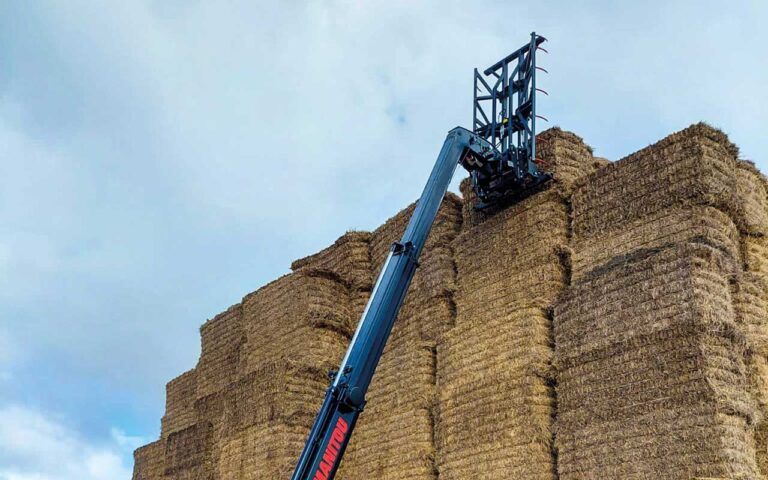It might sound obvious, but when you’re stacking bales seven or eight high, you need a serious bit of kit to handle it.
While an individual bale might not be excessively heavy compared to materials handled a little closer to the ground, when you start to reach heights of 8m or 9m, the strain on the vehicle and the overall stability need to be carefully considered.
Throughout this update, there are a range of uprated engines, powering larger hydraulic systems to provide the upward momentum required.
Through enforced components, some units on the market can provide capacities at full extension of multiple tonnes, while others understandably reduce to just over 1t – still ample for handling straw bales.
Sitting at the top of their respective ranges, these machines also tend to have the highest specification available. This can include a variety of smart hydraulic functions.
While bucket shake isn’t much use when placing bales nearly 10m in the air, synchronising the boom extension and the vertical lift can keep the load on a straight vertical line, making it quicker and easier to stack. Similarly, return-to-dig functions can automatically stop the forks or bucket from hitting the ground when the operator pushes the controls forward.
Automating various functions can speed up the process of stacking and unstacking product; a key efficiency when large-scale merchants are dealing with thousands of bales a year, with multiple lorries appearing daily.
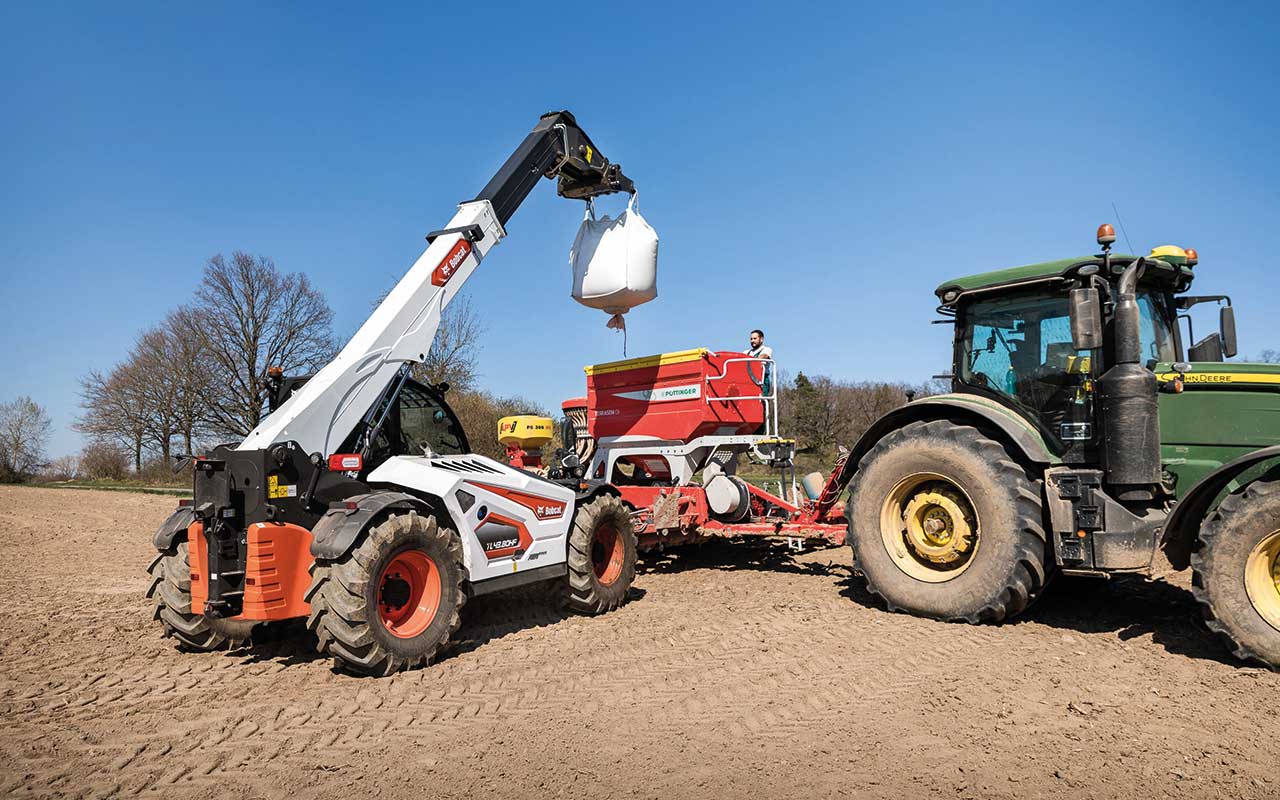
Bobcat
Bobcat’s latest-generation R-series telehandler range provides a choice of seven models with stage V engines. They cover maximum lifting capacities of 2.5-4.3t with lifting heights of 6-8m.
Sitting at the top of the range is the TL43.80HF, though many of the features are common across the range. A series of automated boom functions have been integrated, including Max Lift angle, in which the operator sets the desired max boom angle to limit the working area at height. This feature can help to prevent collisions when working in low-ceiling buildings.
Return-to-ground is also fitted, allowing the operator to set the desired work position (angle of the boom retracted). As the boom is lowered, it self-retracts and stops when the memorised position is reached.
This feature allows the operator to start working faster and avoids damaging the ground or attachment.
Auto Grab means there is no need for the operator to keep their thumb on the roller to open or close the grapple bucket or any clamp attachment. Instead, they just over-press the roller and the action happens automatically.
The Bobcat multifunctional joystick enables faster operations, including these advanced systems.
The FNR button located at the back of the joystick is easily controlled using the index finger, allowing the operator to use their thumb to actuate the usual boom and auxiliary functions and new smart functions such as Auto Grab, the bucket shaking feature, the boom float and the speed-shifting system.
All R-series loaders have an engine hood with a steeper profile that increases visibility and reduces blind spots by 15% on the right-hand side of the machine. This high visibility from the cab is boosted with 360deg LED work lights.
Job Manager functionality allows the operator to save and recall custom settings for different attachments or applications to quickly work with the best machine settings such as auxiliary flows in/out, boom speeds, Auto Grab, creep or reverse fan timing.
The operator can also quickly shift from smooth drive to Dynamic drive, where more rapid machine performance is required, with faster forward and backward shifting and more rapid acceleration and deceleration phases.
Flex Drive mode uses the hand throttle to adjust the engine speed independently from the forward speed, which is operated with the right pedal.

Claas
Of the eight models in the Claas Scorpion telescopic handler range, the majority offer lift heights of about 7m, while two stand out due to their high lift heights – the Scorpion 960 Varipower Plus and the Scorpion 1033 Varipower.
Lift heights range from 8.79m with a maximum capacity of 6t for the 960, rising to 9.75m for the 1033, which has a maximum load capacity of 3.3t.
The smaller-frame Scorpion 1033 is powered by a 143hp Liebherr engine that develops 550Nm of torque, put to the ground through the Varipower 2 transmission.
The larger-frame Scorpion 960 is powered by a 156hp Deutz engine that develops 609Nm of torque driving through a Varipower Plus transmission.
In addition to a wide-angle 45deg hydrostat, this also features a variable displacement motor that swivels through 32deg.
According to the company, it has the benefit of delivering more pushing power to fully maximise the engine torque. With both transmissions, ground speed and thrust are fully coordinated to keep fuel consumption to a minimum.
All Scorpion models are fitted with regenerative working hydraulics with load-free lowering of the boom, decoupled from the engine speed.
Oscillating damping of the boom, which automatically switches off at speeds below 7kph, and automatic bucket shake are standard, plus there is the option of side supports for greater stability when the arm is extended.
Various standard and optional Smart Loading functions are available to aid productivity and precision, while the Dynamic Power system automatically adjusts the engine speed relative to the joystick angle. These allow several functions to be operated with just one command.
The Scorpion 1033 comes with a 160-litre/min load-sensing hydraulic system, while the 960 has a larger 187-litre/min system. Both have a maximum operating pressure of 270bar.
Standard on the Scorpion 960 and optional on the 1033 is a precision control system, whereby pressure of the working hydraulics is automatically halved for greater precision and fine control when working at height.
Both machines feature hydraulic self-levelling of +/- 8deg between the frame and front axle as standard, with a spirit level fitted in the cab.
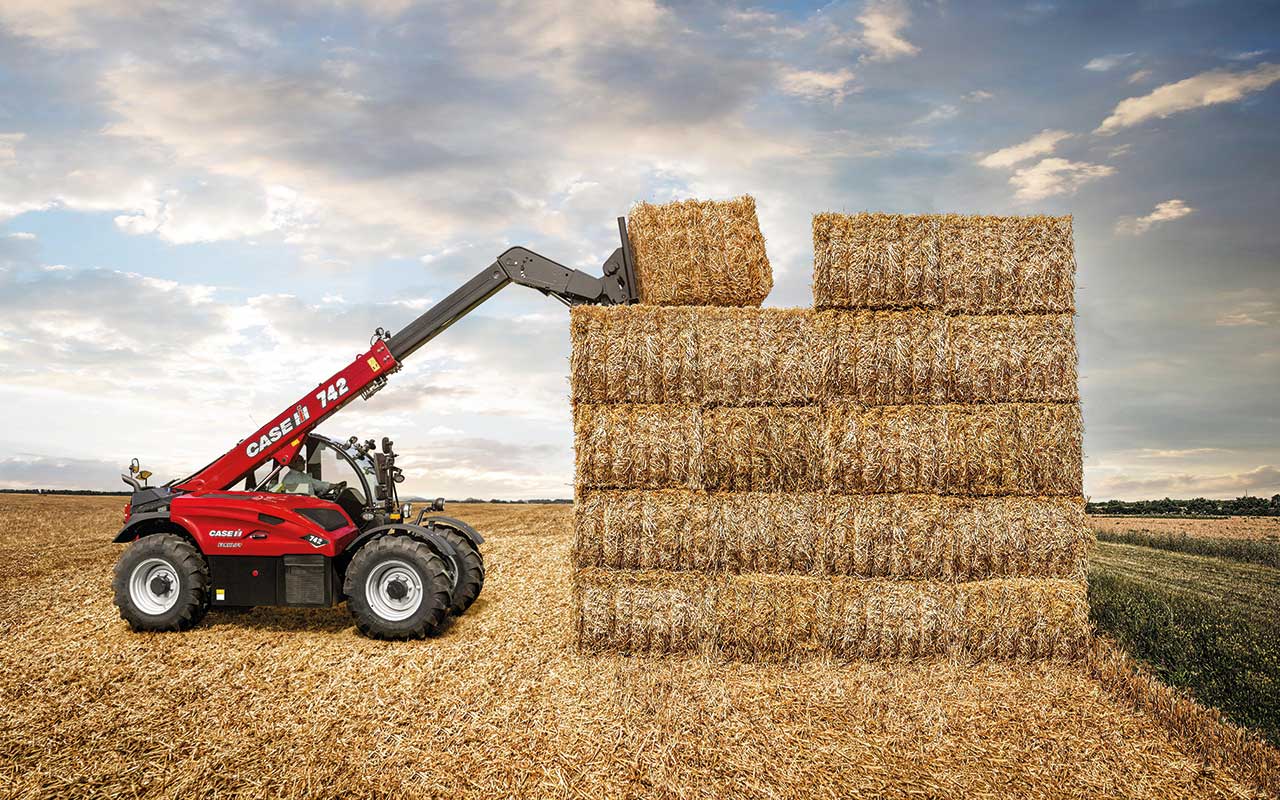
Case IH
The Farmlift 935 sits at the top of the Case IH telehandler range, offering a 3.5t lift capacity and a maximum reach of 9.2m. The latest updates include the integration of the 6×3 PowerDrive powershift gearbox, while this model retains the previous 140-litre/min hydraulic system.
Handling capabilities have been improved by the integration of the EIMA 2022 award-winning electro-hydraulic self-levelling attachment carriage system. T
This replaces the conventional compensation cylinder with two angle sensors that provide real-time position information to an ECU. The machine’s software then instantly calculates the tilt cylinder’s exact oil flow requirement, optimising self-levelling accuracy.
Material losses and maintenance are said to be minimised, while complexity is reduced.
Operating modes can be selected to suit tasks. In transport mode, boom hydraulics are disabled, smooth power shuttling is enabled and two-wheel steer engaged, while in loading mode fast shuttling and rapid boom movement are prioritised.
In handling mode, suited to handling applications such as unloading trucks or stacking bales, default settings are resumed, while the combination of synchronised boom extension/retraction alongside vertical lift improves cycle times and eases operation.
In the cabin, a new control layout is said to improve ergonomics. A 7in colour LCD screen makes key machine data easy to read and, via a navigation encoder, allows key settings and adjustments to be made.
All models are now AFS Connect-ready and supplied with a one-year AFS Connect telematics subscription, for machine data monitoring and alert provision.
On machines with the new rear-view camera, the LCD screen can also display its images when reverse is engaged. Adjacent to the screen, an LED-based load moment indicator with stable risk level warns if maximum load capability is approaching and hydraulic lock-out imminent.
The new adjustable seat-mounted operating armrest incorporates an integrated keypad for easy access to key functions, plus a new joystick with integral hydraulic, transmission and shuttle controls.
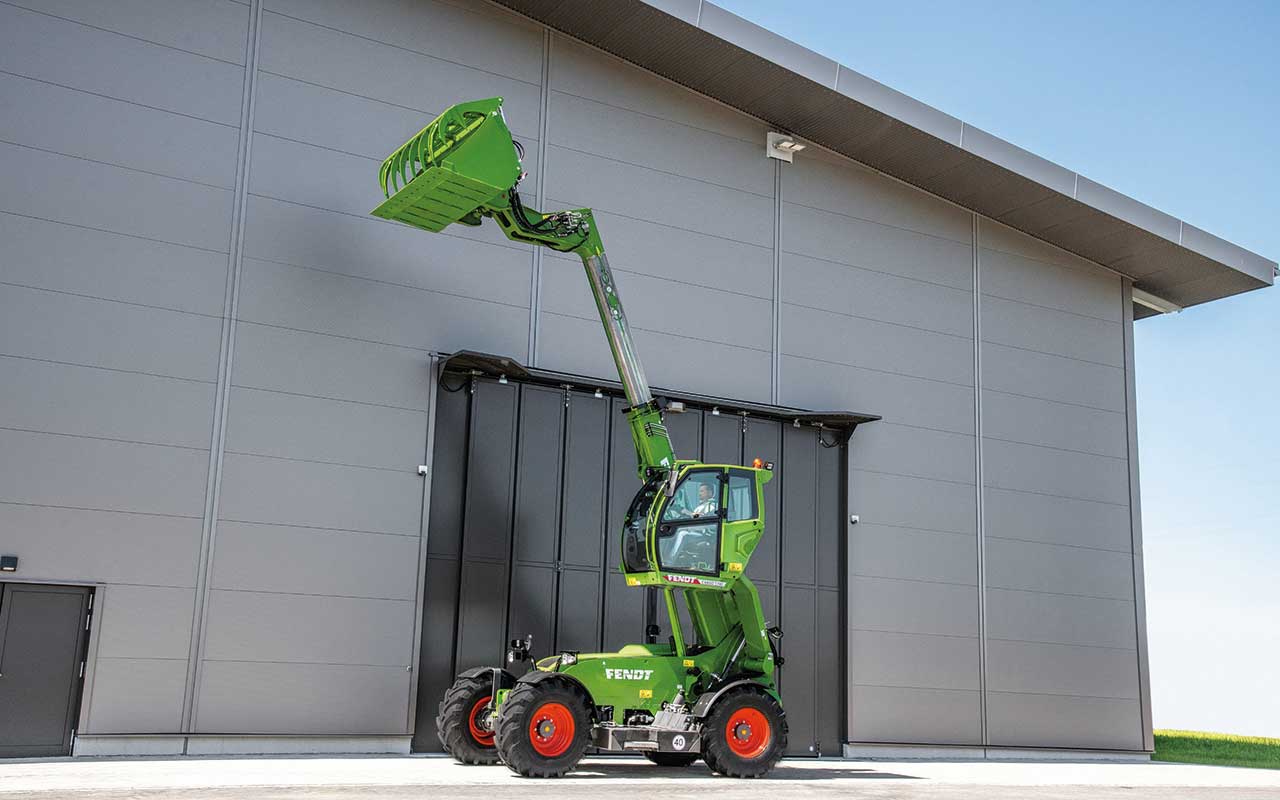
Fendt
The new Fendt Cargo T740 telescopic loader has a lifting height of 7.7m and a lifting capacity of 4t. Unique to the machine is the new generation of Fendt TopViewCab lift cage with vibration damping.
It enables the cab to be raised to an eye level of 4.1m and allows a direct view into trailers or feeder mixers during loading. When manoeuvring, the unrestricted view also increases safety. Aiding this is the fact that the continuous curved front window from the roof to the floor is not covered by a dashboard.
The oscillating control console is integrated on the right side of the driver’s seat and allows operating precision regardless of the operating environment. The colouring of the operating buttons corresponds to the Fendt logic, so users can quickly familiarise themselves.
If the same cab position is repeatedly required for work operations, this position can be stored via the memory function.
Drivers can, for example, determine the maximum cabin height for stall entrances and recall it repeatedly. When the function is activated, the cab lifts up to the stored height.
Due to its Z kinematics, the Fendt Cargo T740 achieves a breakaway force of 65kN on the bucket – a power comparable to that of a wheel loader, according to the company.
The hydraulic system has a flow capacity of 170 litre/min for sensitive control of all hydraulic functions, including the lifting arm and the cab.
The four-cylinder Cummins engine offers 136hp, which is transferred through a hydrostatic transmission. The standard speed is 20kph.
Optionally, speeds of 30kph or 40kph are also possible so that the Fendt Cargo T740 can be used in transport applications. With a 400/70 R24 tyre, the vehicle height of the Fendt Cargo T740 is below 2.5m. A tyre size of 500/70 R24 is also available.
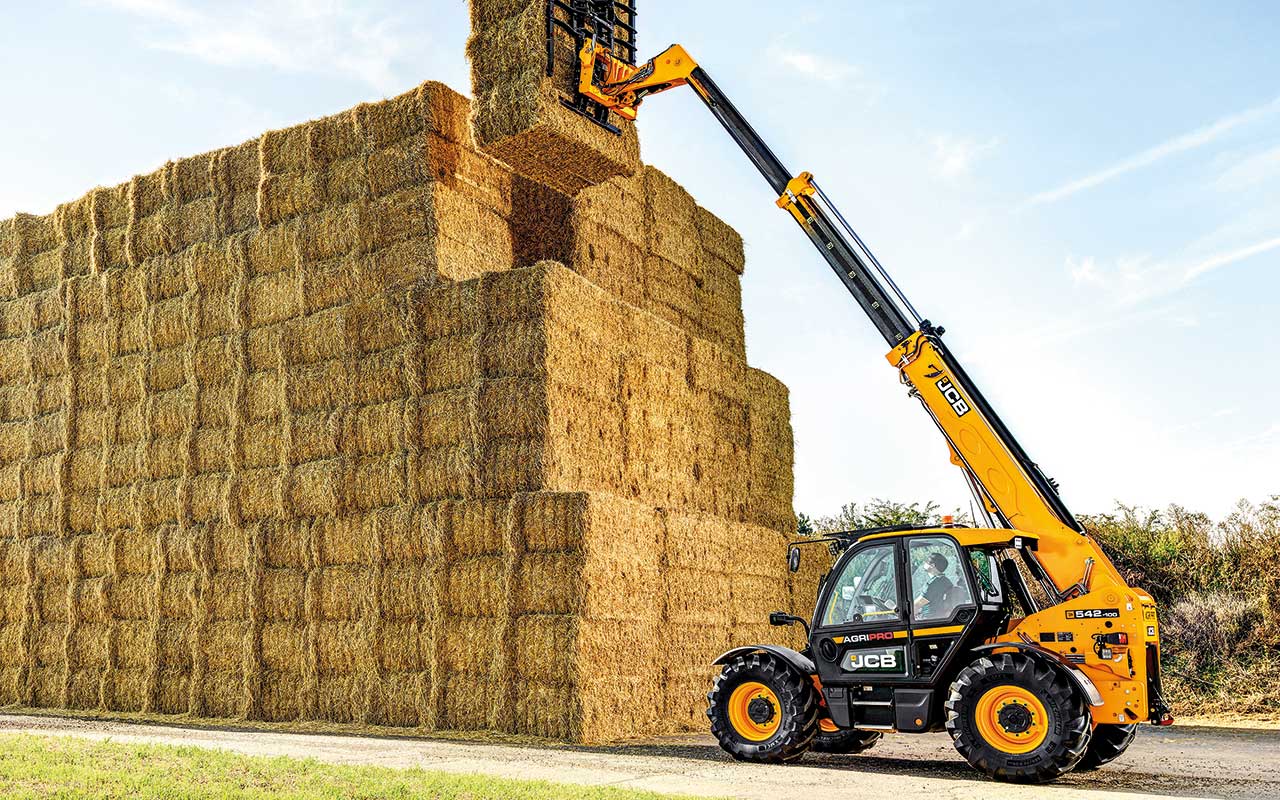
JCB
The all-new JCB Loadall 542-100 is built with an uprated chassis and boom design, enabling a maximum load capacity of 4.2t and 9.8m lift height – both significant gains over the current 536-95, but with no increase in overall size.
The Loadall 542-100 is capable of handling heavier loads throughout the boom extension, culminating in 1.8t of lift at the maximum height.
Adding to this is the Sway Control chassis-to-axle levelling feature available on Agri Xtra and Agri Pro models, which keeps the boom vertical on sloping or uneven ground.
JCB says the machine is well suited to tasks such as grain store outloading and other routine jobs thanks to its lift capacity of 4.2t, available up to about 5.8m, and 3t to 7.8m.
High-capacity hydraulics are fitted with a 160-litre/min flow-on-demand pump and a regenerative circuit that allows the boom to be brought down rapidly but under full control, ensuring fast retrieval cycles.
All versions of the Loadall 542-100 are equipped with JCB’s DualTech VT transmission, which provides initial movement by hydrostatic drive for precise control before automatically switching to direct drive powershift at faster field and road speeds for maximum power and fuel efficiency.
The Agri Super model is powered by a 130hp, 550Nm version of JCB’s 4.8-litre DieselMAX engine, while the Agri Xtra, which adds air conditioning, LED lighting, limited slip front axle differential, boom extension dust covers and centralised greasing to the base specification, has a 150hp, 600Nm power unit.
In the highest-specification Agri Pro form, the Loadall 542-100 is significantly more powerful at 173hp and 690Nm, and is also faster thanks to a 50kph DualTech VT transmission.
The new high-lift machine benefits from heavier-duty axles with 10-stud hubs, wider 500/70R24 traction grip, hybrid or hard-surface tyres, full-time four-wheel drive with auto-selectable two-wheel drive for road travel, and a dual-axle power braking system.
A new option for all full-size JCB Loadall telehandlers is IntelliWeigh Lite, a load weighing system that operators can use to record all materials handled or loaded.
The factory-installed system can be easily calibrated with different attachments, with the weight of each load and the number of loads per session recorded to give a total tonnage.
Static and dynamic on-the-move weighing can be handled, and there is a pause function if the loading cycle is interrupted by a different task. Operators can also set a countdown target weight to ensure precise loading of several ration ingredients or to prevent overloading of road trucks and trailers.
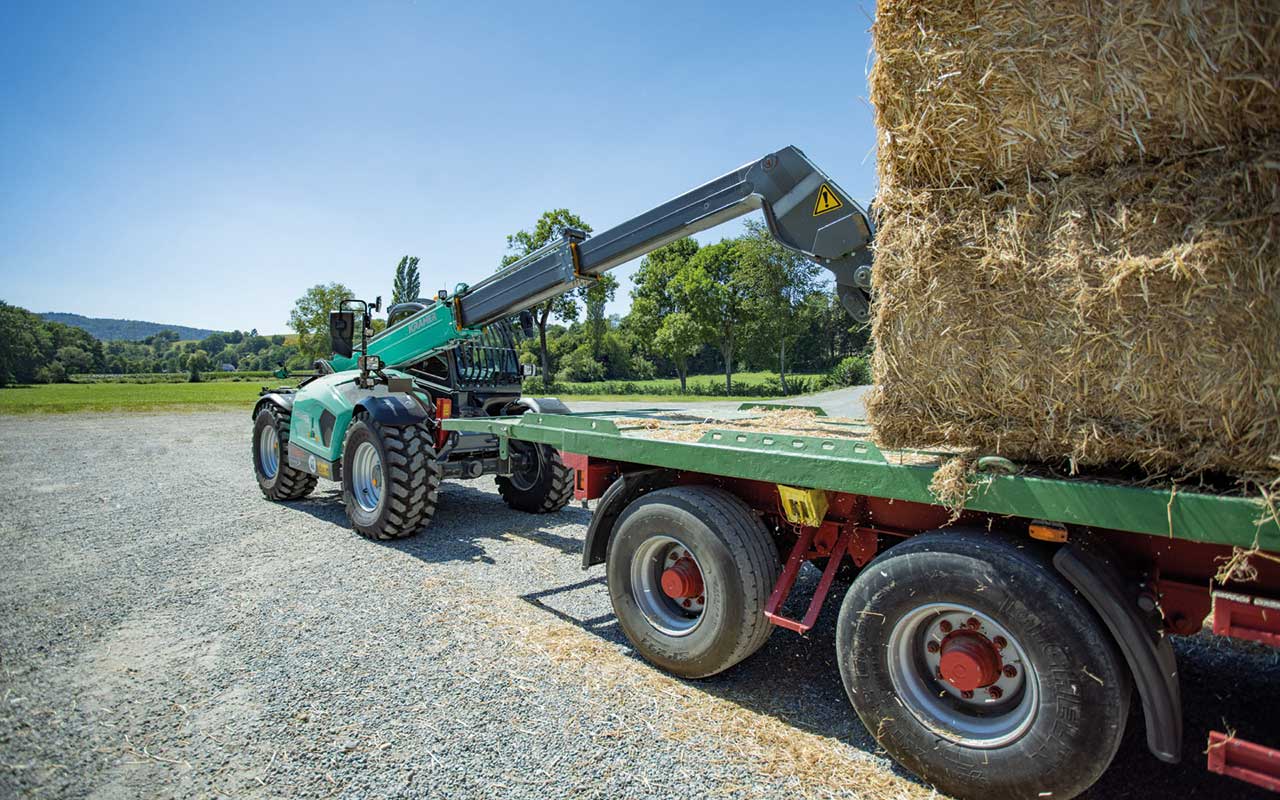
Kramer
With the KT3610, Kramer offers a maximum lift height of 9.5m, while maintaining a compact design thanks to the three-piece boom. It has an operating weight of 8.2t (depending on options) and a maximum payload of 3.6t.
There are also two cabin options available for the KT3610. According to the company, the standard cabin is ideally suited to low stables and passageways.
With its standard 24in tyres, the vehicle has a total height of just 2.31m, which Kramer says is unique in this class of machine. Notably, it’s also a compact unit, with a total length without the bucket of just over 5m and a width of 2.285m.
If the maximum vehicle height is not a limiting factor, there is an option available for an 18cm raised cab for all-round visibility, particularly to the right-hand side.
Power comes from a Deutz engine, offering 134hp, put to the ground through a 30kph hydrostatic drive. Four steering modes are available to suit the environment being worked in, with all-wheel, front-axle steering, crab steer and manual-adjustment crab steering.
The hydraulic system is rated at 140 litres/min, with a continuous third function operated via a toggle switch.
Smart Handling, intelligent overload protection, automatic bucket return and the telematics solutions – EquipCare – are fitted as standard. Additionally, as with the previous KT407 model, you can fall back on the same range of options.
It is offered alongside the previous KT407, which has the same dimensions but offers a 4t payload and a smaller lift height of 7m.
Kramer also produces the KT559, which has a stacking height of 8.75m and increases the lift capacity to 5.5t.
This comes in a larger overall package, however, with a 156hp Deutz engine, uprated hydraulics of 187 litre/min and a 5.6m-long body, extending to 2.5m wide. As such, the more powerful KT559 is better suited to open yard and field work.
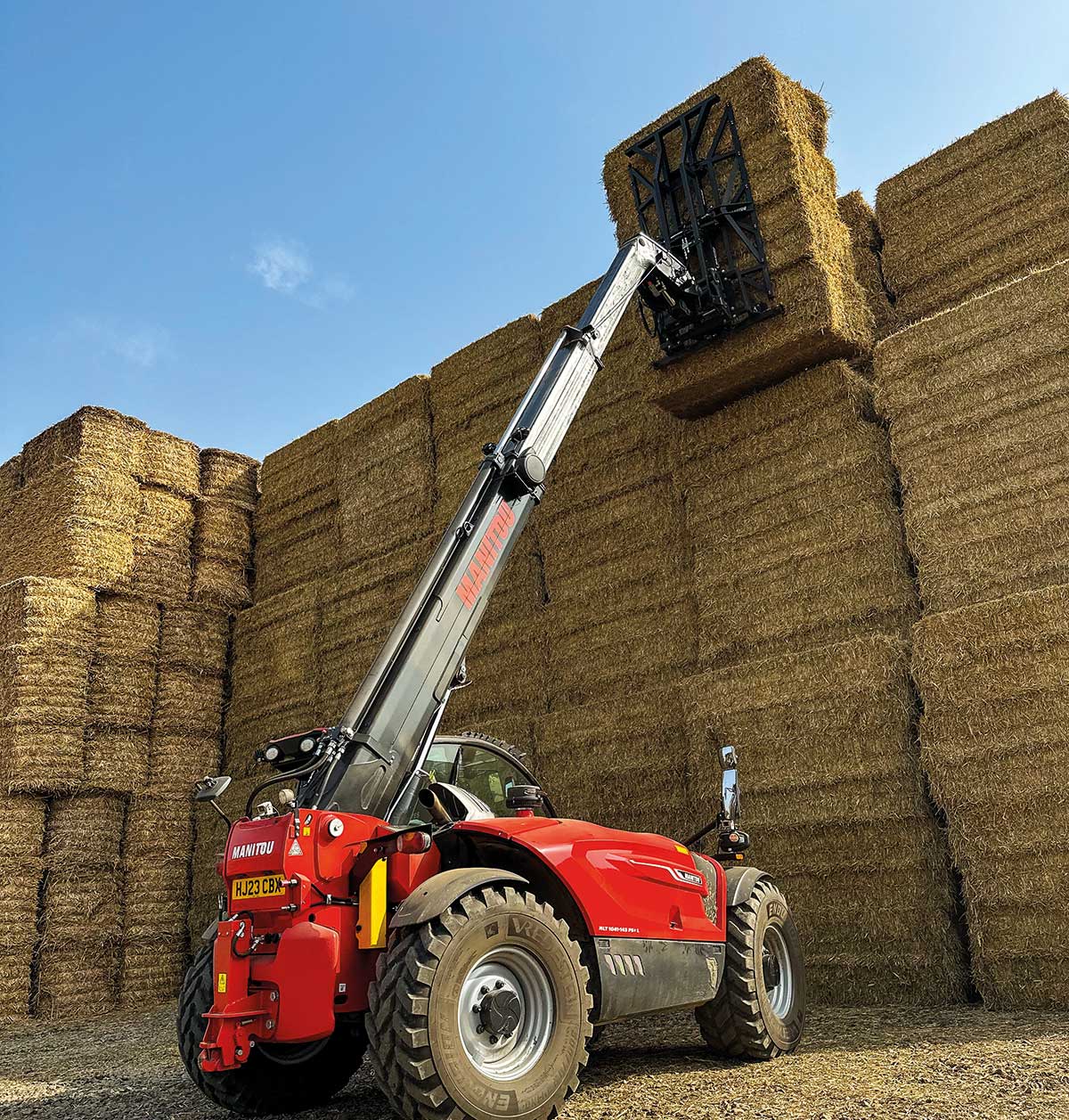
Manitou
To extend its offering of NewAg agricultural telehandlers, Manitou Group launched the NewAg XL range with two new models, the MLT 841 and MLT 1041, with a capacity of more than 4.1t for a lifting height of 7.6m or 9.65m.
According to the company these have been designed for intensive applications with usage of over 1,300 hours/year, and are aimed primarily at large farms (polyculture, cereal crops and biogas), agricultural contractors, cooperatives and agri-businesses.
Matching the desired output, these models are fitted with a 141hp engine, delivering 12% of additional torque while reducing fuel consumption by 11% compared with previous models.
This torque gain helps to improve the towing and loading performance, with power put to the ground through a torque converter transmission and automatic powershift gearbox. These features are bolstered by a hydraulic flow of 200 litres/min.
Numerous options have been added to the array of equipment: the High View camera, which allows the operator to view the inside of the trailer when loading, and the Active CRC boom suspension, which reduces jolting when driving with a load.
Also included are the Comfort Steering System with variable assist steering, which reduces the number of steering wheel turns by 40%, and the Intelligent Hydraulics package (bucket shaker, return to load position and combined telescopic boom movements).
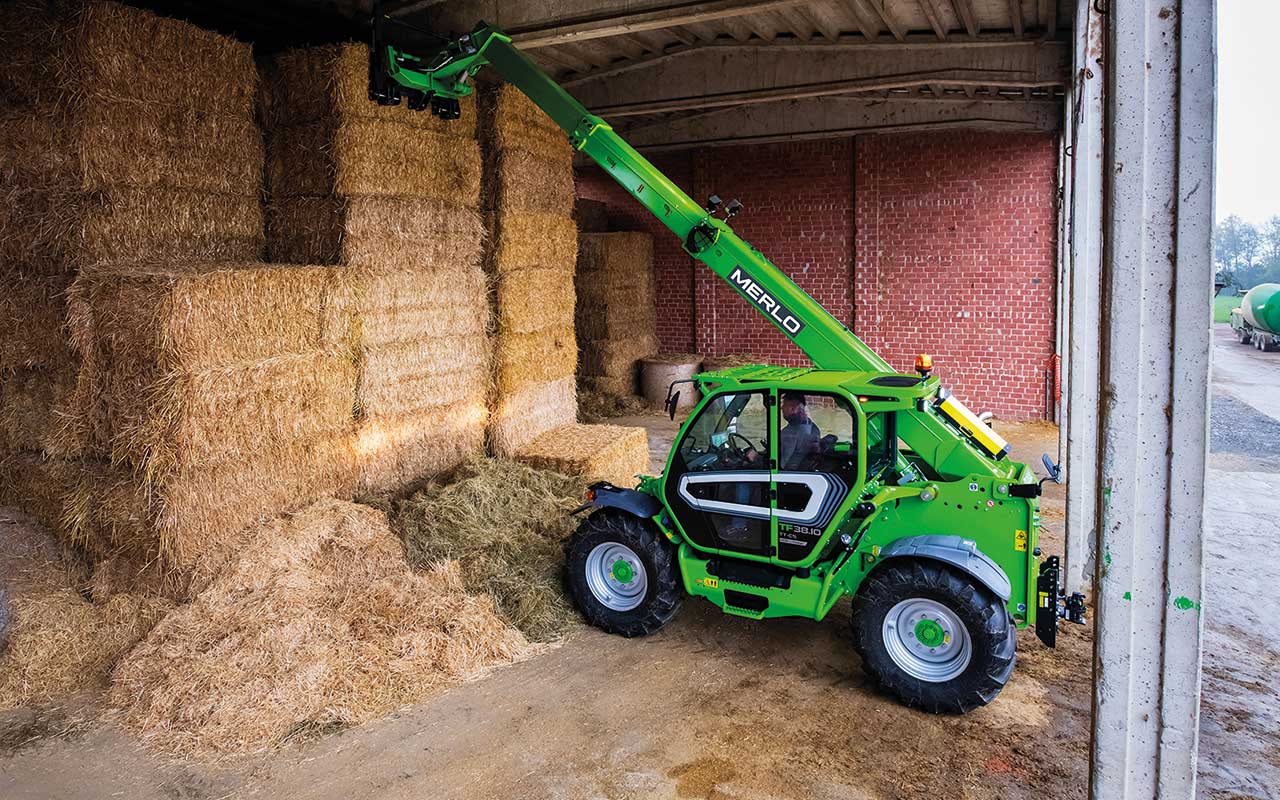
Merlo
Merlo offers two high-reach telehandlers for straw stacking: the TF38.10 and TF45.11. The TF38.10 boasts a 3.8t maximum lift with a 9.7m height, capable of handling an impressive 3t at full lift height. The TF45.11 delivers a 4.5t maximum lift, a 10.6m reach, and 3.5t capacity at max lift.
Both models feature the TT system (frame levelling and boom side shift), which allows the machine to be hydraulically levelled.
The boom side shift moves the entire machine left or right on the front axle, extending movement at the boom head for tighter stacking and efficient truck loading.
Said to be unique on the market is Merlo’s cab suspension, which provides 110mm of travel. For added comfort, both models can be fitted with boom suspension.
The TF45.11 is available with a 170hp FPT engine, while the TF38.10 is equipped with either a 143hp Deutz engine (optionally put to the ground through the company’s CVTronic gearbox) or a 136hp Perkins engine (standard hydrostatic transmission).
Merlo’s Eco Power Drive system is said to enhance fuel efficiency by electronically managing the engine and transmission separately, reducing fuel consumption by up to 18%.
It also features a self-accelerating joystick, allowing the operator to set the engine rev range. Joystick actions adjust the engine revs proportionally, enabling the operator to focus on the attachment and task at hand.
Both machines feature load-sensing and flow-sharing to deliver fast, accurate cycle times. The TF45.11 features a high-flow hydraulic pump, rated at 166 litres/min, compared to the TF38.10’s 145 litres/min.
Standard features across the Turbo Farmer range include full front and rear differentials, engaged via a yellow floor button for tough conditions. Additionally, the hydraulic pick-up hitch supports a 2.5t tongue weight, allowing for a 24t towing capacity
Merlo’s Adaptive Stability Control System provides a real-time load chart, ensuring operators can monitor load position and capacity at any given moment.

New Holland
The TH range from New Holland peaks at 9.35, available in both Plus and Elite specifications. The option of two specifications provides either 133hp or 145hp, respectively, from the NEF engine.
Transmission options also differ. While both feature the same 6×3 powershift box, on Plus models this can be operated in manual or semi-automatic modes, while Elite machines benefit from a fully automatic mode.
Regardless of the specification package chosen, the New Holland flagship can handle up to 3.5t and can lift to a maximum height of 9.1m.
As with the rest of the range, the 9.35 is equipped with the 360deg Vision Cab, which features a wide and deep front windscreen and slim A-pillars to reduce blind spots around the boom. All models also feature an armrest-mounted electronic joystick with transmission and shuttle controls, as well as a toggle for the third service.
A new 7in display has been fitted into the right-hand side of the dashboard, clearly highlighting machine parameters. This also links to the rear camera when the machine is shifted into reverse. To monitor the stability and load of the machine, a Load Moment Indicator is fitted, which monitors the rear axle and uses a traffic light system to indicate the tipping risk.
Plus models feature a 140-litre/min hydraulic system, increasing to 160 litres on Elite machines. This not only minimises cycle times but also diverts more power through the transmission to boost transport and clamp operations.
Cycle times can be as low as 6.7sec for lifting on the 9.35, or 7.9sec for full extension. Hydraulic power management is also integrated, increasing the engine speed to provide more pushing power as required.
Various operating modes are included, such as Forklift mode, which automates the extension and retraction of the boom in line with the vertical lift. This keeps the load on a straight vertical line to ease stacking.
The aggressiveness of boom movements can be adjusted to suit the operation at hand.


